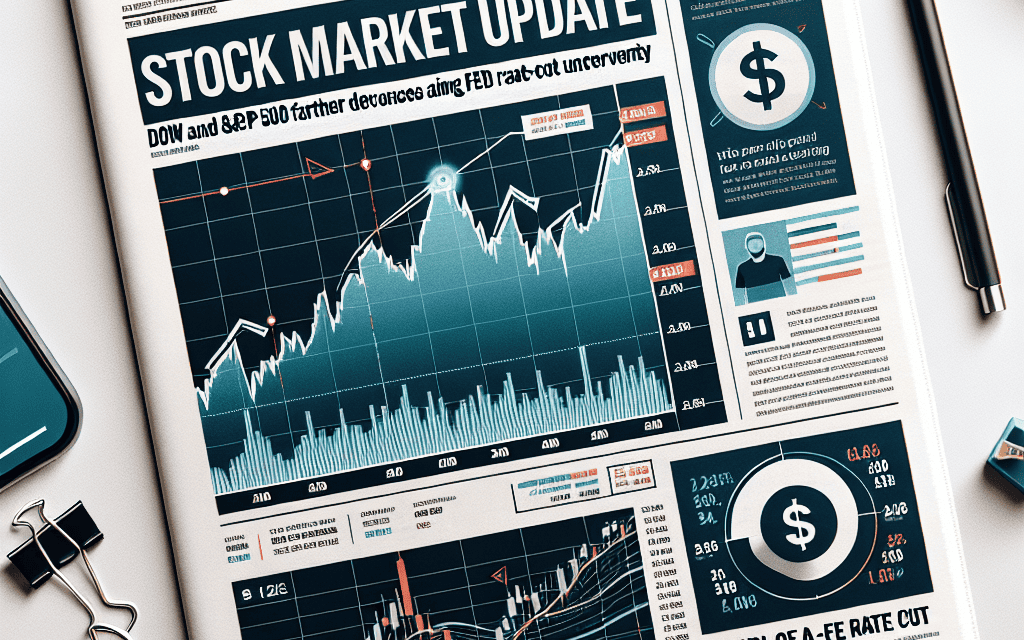“Market Jitters: Dow and S&P 500 Tumble as Fed Rate-Cut Uncertainty Looms”
Introduction
The stock market continues to navigate turbulent waters as the Dow Jones Industrial Average and the S&P 500 face further declines, driven by growing uncertainty surrounding potential Federal Reserve rate cuts. Investors are grappling with mixed economic signals and the Fed’s cautious stance on monetary policy adjustments, which have fueled volatility across financial markets. As market participants weigh the implications of interest rate decisions on economic growth and corporate earnings, the persistent ambiguity is contributing to a cautious investment environment. This backdrop of uncertainty underscores the challenges faced by traders and analysts in predicting market trajectories, as they closely monitor economic indicators and central bank communications for clearer guidance.
Impact Of Fed Rate-Cut Uncertainty On Stock Market Trends
The stock market has been experiencing a tumultuous period, with the Dow Jones Industrial Average and the S&P 500 facing further declines. This downturn can be largely attributed to the prevailing uncertainty surrounding potential rate cuts by the Federal Reserve. Investors are closely monitoring the Fed’s actions, as interest rate decisions have significant implications for the broader economy and, consequently, the stock market. The anticipation of rate cuts often leads to increased market volatility, as investors attempt to predict the Fed’s next move and adjust their portfolios accordingly.
In recent months, the Federal Reserve has been under pressure to address concerns about slowing economic growth and rising inflation. While some market participants advocate for rate cuts to stimulate economic activity, others caution against such measures, fearing they could exacerbate inflationary pressures. This division has created a sense of uncertainty, leaving investors in a state of flux as they await clearer signals from the Fed. The lack of consensus on the appropriate monetary policy path has contributed to the recent declines in the Dow and S&P 500, as investors grapple with the potential implications of various scenarios.
Moreover, the global economic landscape adds another layer of complexity to the situation. Geopolitical tensions, supply chain disruptions, and fluctuating commodity prices have all played a role in shaping investor sentiment. These factors, combined with the Fed’s indecision, have led to increased market volatility. As a result, investors are finding it challenging to navigate the current environment, with many opting for a cautious approach until more definitive guidance is provided by the Federal Reserve.
In addition to the broader economic factors, corporate earnings reports have also influenced market trends. Companies across various sectors have reported mixed results, reflecting the uneven recovery from the pandemic-induced downturn. While some firms have demonstrated resilience and adaptability, others continue to face headwinds, further complicating the investment landscape. This disparity in corporate performance has contributed to the overall uncertainty, as investors weigh the potential risks and rewards associated with different sectors and individual stocks.
Furthermore, the bond market has also been impacted by the Fed’s rate-cut uncertainty. Yields on government bonds have fluctuated as investors adjust their expectations regarding future interest rate movements. This has led to a reallocation of assets, with some investors seeking refuge in safer investments, while others pursue higher returns in riskier assets. The interplay between the stock and bond markets underscores the interconnectedness of financial markets and the far-reaching effects of the Fed’s policy decisions.
In light of these developments, market participants are eagerly awaiting the Federal Reserve’s upcoming meetings and statements for any indications of a shift in monetary policy. The Fed’s communication strategy will be crucial in managing market expectations and providing clarity to investors. Until then, the stock market is likely to remain volatile, with the Dow and S&P 500 potentially facing further fluctuations as investors react to new information and adjust their strategies accordingly.
In conclusion, the uncertainty surrounding potential rate cuts by the Federal Reserve has had a profound impact on stock market trends, contributing to the recent declines in the Dow and S&P 500. As investors navigate this challenging environment, they must remain vigilant and adaptable, considering both domestic and global factors that could influence market dynamics. The coming months will be critical in determining the direction of the stock market, as the Fed’s decisions and communications play a pivotal role in shaping investor sentiment and market trends.
Analyzing The Dow’s Recent Performance Amid Economic Shifts
The recent performance of the Dow Jones Industrial Average has been a focal point for investors and analysts alike, as economic shifts and policy uncertainties continue to shape market dynamics. In recent weeks, the Dow has experienced further declines, reflecting a broader trend of volatility that has gripped the stock market. This downturn can be attributed to a confluence of factors, with the uncertainty surrounding potential Federal Reserve rate cuts playing a pivotal role. As investors grapple with these developments, it is essential to analyze the underlying causes and potential implications for the market.
To begin with, the Federal Reserve’s monetary policy has been a significant driver of market sentiment. The anticipation of interest rate adjustments often leads to fluctuations in stock prices, as investors recalibrate their expectations for economic growth and corporate profitability. In the current climate, the ambiguity surrounding the Fed’s next move has created a sense of unease. While some market participants hope for rate cuts to stimulate economic activity, others fear that such measures may signal deeper economic troubles. This dichotomy has contributed to the Dow’s recent performance, as investors weigh the potential benefits and risks of future rate changes.
Moreover, the broader economic landscape has also influenced the Dow’s trajectory. Recent data releases have painted a mixed picture of the U.S. economy, with some indicators suggesting resilience while others point to potential weaknesses. For instance, while consumer spending has remained relatively robust, manufacturing output has shown signs of slowing. This divergence has added another layer of complexity to the market’s outlook, as investors attempt to discern the overall health of the economy. Consequently, the Dow’s performance has mirrored these uncertainties, with fluctuations reflecting the market’s struggle to find a clear direction.
In addition to domestic factors, global economic conditions have also played a role in shaping the Dow’s recent performance. Trade tensions, geopolitical uncertainties, and slowing growth in key international markets have all contributed to a cautious investment environment. As the interconnectedness of global economies becomes increasingly apparent, developments abroad can have significant repercussions for U.S. markets. The Dow, as a barometer of American economic health, is particularly sensitive to these external influences, which can exacerbate existing volatility.
Furthermore, corporate earnings reports have added another dimension to the Dow’s recent performance. As companies release their financial results, investors scrutinize these figures for insights into future profitability and growth prospects. In some cases, earnings have exceeded expectations, providing a temporary boost to stock prices. However, in other instances, disappointing results have led to sharp declines, further contributing to the Dow’s overall downward trend. This earnings season has underscored the importance of company-specific factors in shaping market outcomes, even amid broader economic uncertainties.
In conclusion, the recent performance of the Dow Jones Industrial Average reflects a complex interplay of factors, including Federal Reserve policy uncertainty, mixed economic data, global influences, and corporate earnings. As investors navigate this challenging landscape, the need for careful analysis and strategic decision-making becomes increasingly apparent. While the path forward remains uncertain, understanding the underlying drivers of market movements can provide valuable insights for those seeking to make informed investment choices. As the situation continues to evolve, staying attuned to these dynamics will be crucial for anticipating future trends and potential opportunities in the stock market.
S&P 500 Declines: Key Factors Influencing Market Movements
The recent performance of the S&P 500 has been marked by a series of declines, reflecting a broader trend of uncertainty in the stock market. This downturn can be attributed to several key factors, each playing a significant role in shaping investor sentiment and market movements. At the forefront of these influences is the ongoing uncertainty surrounding the Federal Reserve’s monetary policy, particularly the ambiguity regarding potential rate cuts. Investors are closely monitoring the Fed’s actions, as any indication of a shift in interest rates could have profound implications for the market. The anticipation of rate cuts often leads to increased market volatility, as investors attempt to predict the Fed’s next move and adjust their portfolios accordingly.
In addition to the uncertainty surrounding the Federal Reserve’s decisions, global economic conditions are also exerting pressure on the S&P 500. The interconnectedness of global markets means that economic slowdowns in major economies can have ripple effects across the world. Recent data indicating sluggish growth in key regions such as Europe and China has heightened concerns about a potential global economic downturn. This, in turn, has led to increased caution among investors, who are wary of the potential impact on corporate earnings and overall market performance.
Moreover, geopolitical tensions continue to be a significant factor influencing market dynamics. Ongoing trade disputes, particularly between the United States and China, have created an environment of uncertainty that weighs heavily on investor confidence. The lack of a clear resolution to these disputes has led to concerns about the potential for further escalation, which could disrupt global supply chains and negatively affect economic growth. As a result, investors remain on edge, closely watching for any developments that could signal a shift in the geopolitical landscape.
Corporate earnings reports also play a crucial role in shaping market movements, and recent earnings seasons have been a mixed bag. While some companies have reported strong results, others have fallen short of expectations, leading to increased volatility in the stock market. Investors are particularly focused on forward guidance from companies, as this provides insight into how businesses are navigating the current economic environment. Any indication of slowing growth or reduced profitability can lead to sharp declines in stock prices, further contributing to the overall downward trend in the S&P 500.
In light of these factors, it is clear that the current market environment is characterized by a high degree of uncertainty and volatility. Investors are grappling with a complex web of influences, each of which has the potential to significantly impact market performance. As such, many are adopting a cautious approach, opting to wait for clearer signals before making significant investment decisions. This cautious stance is reflected in the recent declines in the S&P 500, as market participants remain wary of the potential for further downside.
In conclusion, the recent declines in the S&P 500 can be attributed to a combination of factors, including uncertainty surrounding Federal Reserve policy, global economic conditions, geopolitical tensions, and mixed corporate earnings reports. Each of these elements contributes to an environment of heightened volatility and caution among investors. As the market continues to navigate these challenges, it remains to be seen how these factors will ultimately influence the trajectory of the S&P 500 in the coming months.
Investor Sentiment: Navigating Market Volatility And Rate-Cut Speculation

Investor sentiment has been notably impacted by the recent fluctuations in the stock market, as the Dow Jones Industrial Average and the S&P 500 continue to face declines. This downturn is largely attributed to the prevailing uncertainty surrounding potential rate cuts by the Federal Reserve. As investors grapple with the implications of these economic signals, market volatility has become a defining characteristic of the current financial landscape. Understanding the interplay between these factors is crucial for navigating the complexities of today’s market environment.
The Federal Reserve’s monetary policy decisions are pivotal in shaping investor expectations and market dynamics. In recent months, speculation about potential rate cuts has intensified, driven by mixed economic indicators and global economic uncertainties. While some investors anticipate that a reduction in interest rates could stimulate economic growth and bolster market confidence, others remain cautious, concerned that such measures may signal underlying economic weaknesses. This dichotomy in investor sentiment has contributed to heightened market volatility, as traders react to each new piece of economic data and Fed commentary.
Moreover, the global economic backdrop adds another layer of complexity to the situation. Trade tensions, geopolitical uncertainties, and fluctuating commodity prices have all played a role in shaping investor perceptions. These factors, combined with domestic economic indicators such as employment rates and consumer spending, create a challenging environment for investors seeking to make informed decisions. As a result, market participants are closely monitoring the Federal Reserve’s communications for any hints of future policy direction, which in turn influences their investment strategies.
In this context, the recent declines in the Dow and S&P 500 can be seen as a reflection of the broader uncertainty that pervades the market. Investors are weighing the potential benefits of a rate cut against the risks of a slowing economy, leading to cautious trading behavior. This cautiousness is evident in the increased demand for safe-haven assets, such as government bonds and gold, as investors seek to mitigate risk amid the prevailing uncertainty.
Furthermore, the role of technology and algorithmic trading in amplifying market movements cannot be overlooked. In today’s fast-paced trading environment, automated systems can exacerbate market swings, as they react instantaneously to news and data releases. This can lead to rapid shifts in market sentiment, further contributing to the volatility observed in recent weeks.
Despite these challenges, some investors view the current market conditions as an opportunity. For those with a long-term perspective, periods of volatility can present attractive entry points for acquiring quality assets at discounted prices. However, this approach requires a careful assessment of individual risk tolerance and a thorough understanding of the underlying economic fundamentals.
In conclusion, navigating the current market volatility requires a nuanced understanding of the factors driving investor sentiment. The uncertainty surrounding potential Federal Reserve rate cuts, coupled with global economic challenges, has created a complex environment for market participants. As investors continue to assess the implications of these developments, maintaining a balanced perspective and staying informed about economic trends will be essential for making sound investment decisions. While the path forward may be fraught with uncertainty, those who can adeptly navigate these challenges may find opportunities amid the turbulence.
Historical Context: How Fed Decisions Have Shaped Market Outcomes
The relationship between Federal Reserve decisions and stock market outcomes has long been a subject of keen interest for investors and analysts alike. Historically, the Federal Reserve’s monetary policy, particularly its decisions regarding interest rates, has played a pivotal role in shaping market dynamics. As the Dow Jones Industrial Average and the S&P 500 face further declines amid uncertainty surrounding potential rate cuts, it is essential to understand the historical context of how such decisions have influenced market behavior.
In the past, the Federal Reserve’s approach to interest rates has often been a balancing act between fostering economic growth and controlling inflation. During periods of economic expansion, the Fed has typically raised interest rates to prevent the economy from overheating. Conversely, in times of economic downturn or uncertainty, the Fed has often cut rates to stimulate growth. These decisions have had profound implications for the stock market, influencing investor sentiment and market performance.
For instance, during the financial crisis of 2008, the Federal Reserve implemented a series of aggressive rate cuts to stabilize the economy. This period saw the federal funds rate drop to near-zero levels, a move that was instrumental in restoring investor confidence and eventually leading to a prolonged bull market. The low-interest-rate environment made borrowing cheaper, encouraging both consumer spending and corporate investment, which in turn fueled stock market growth.
However, the relationship between Fed rate decisions and market outcomes is not always straightforward. While rate cuts are generally perceived as positive for stocks, signaling a more accommodative monetary policy, they can also be interpreted as a response to underlying economic weaknesses. This duality can create uncertainty among investors, as seen in the current market environment where the Dow and S&P 500 are experiencing declines. The ambiguity surrounding the Fed’s next move—whether to cut rates or maintain the status quo—has left investors in a state of flux, contributing to market volatility.
Moreover, the impact of Fed decisions on the stock market is also influenced by external factors such as geopolitical tensions, global economic conditions, and domestic fiscal policies. For example, during the late 1990s, despite a series of rate hikes by the Fed, the stock market continued to soar, driven by the tech boom and robust economic growth. This illustrates that while Fed policy is a significant factor, it is not the sole determinant of market outcomes.
In the current scenario, the uncertainty surrounding potential rate cuts is compounded by concerns over inflation and economic growth. Investors are closely monitoring economic indicators and Fed communications for clues about future policy direction. The anticipation of rate cuts may provide some support to the market, but the lack of clarity on the timing and magnitude of such cuts continues to weigh on investor sentiment.
In conclusion, the historical context of Federal Reserve decisions underscores their critical role in shaping stock market outcomes. While past rate cuts have often led to market rallies, the current environment presents a more complex picture. As the Dow and S&P 500 navigate this period of uncertainty, understanding the interplay between Fed policy and market dynamics remains crucial for investors seeking to make informed decisions.
Strategies For Investors During Periods Of Economic Uncertainty
In times of economic uncertainty, such as the current period marked by the Dow and S&P 500 facing further declines amid Federal Reserve rate-cut uncertainty, investors often find themselves at a crossroads. Navigating these turbulent waters requires a strategic approach that balances caution with opportunity. As the market reacts to the ambiguity surrounding potential interest rate adjustments, investors must consider several strategies to safeguard their portfolios while positioning themselves for future gains.
Firstly, diversification remains a cornerstone of prudent investing, especially during volatile periods. By spreading investments across various asset classes, sectors, and geographic regions, investors can mitigate the risks associated with market fluctuations. This approach not only helps in cushioning the impact of downturns in specific areas but also allows for participation in potential upswings elsewhere. For instance, while equities may be under pressure, bonds or commodities might offer more stability or even growth, depending on the economic climate.
Moreover, maintaining a long-term perspective is crucial. Market volatility can tempt investors to make impulsive decisions based on short-term movements. However, history has shown that markets tend to recover over time, rewarding those who remain patient and committed to their investment strategies. By focusing on long-term goals and resisting the urge to react to daily market noise, investors can avoid the pitfalls of emotional decision-making.
In addition to diversification and a long-term outlook, investors should also consider the role of cash in their portfolios. Holding a portion of assets in cash or cash equivalents can provide a buffer against market downturns and offer liquidity to take advantage of buying opportunities when valuations become attractive. This strategy allows investors to remain flexible and responsive to changing market conditions without being forced to sell assets at a loss.
Furthermore, it is essential for investors to stay informed about economic indicators and central bank policies. Understanding the factors driving market movements can help in making more informed decisions. For example, the current uncertainty surrounding Federal Reserve rate cuts highlights the importance of monitoring inflation rates, employment data, and other economic signals that could influence monetary policy. By staying abreast of these developments, investors can better anticipate potential market reactions and adjust their strategies accordingly.
Additionally, consulting with financial advisors or investment professionals can provide valuable insights and guidance during uncertain times. These experts can offer personalized advice based on an individual’s risk tolerance, financial goals, and current market conditions. Their expertise can be instrumental in crafting a strategy that aligns with an investor’s unique circumstances while navigating the complexities of the market.
Finally, it is important to remember that economic uncertainty is an inherent part of investing. While it can be challenging, it also presents opportunities for those who are prepared and strategic. By employing a diversified approach, maintaining a long-term perspective, holding cash reserves, staying informed, and seeking professional advice, investors can better position themselves to weather the storm and potentially benefit from future market recoveries.
In conclusion, while the current declines in the Dow and S&P 500 amid Fed rate-cut uncertainty may cause concern, they also serve as a reminder of the importance of strategic planning and disciplined investing. By adopting these strategies, investors can navigate periods of economic uncertainty with greater confidence and resilience.
Future Outlook: Predicting Market Reactions To Potential Fed Actions
As investors navigate the turbulent waters of the stock market, the recent declines in the Dow Jones Industrial Average and the S&P 500 have sparked widespread concern. The uncertainty surrounding potential Federal Reserve actions, particularly regarding interest rate cuts, has left market participants on edge. Understanding the future outlook of these indices requires a careful examination of the factors at play and the potential reactions to forthcoming Fed decisions.
The Federal Reserve’s monetary policy is a critical driver of market sentiment, and its decisions on interest rates can significantly influence investor behavior. In recent months, speculation about the Fed’s next move has intensified, with some analysts predicting rate cuts to counteract economic headwinds. However, the timing and magnitude of such cuts remain uncertain, creating a cloud of ambiguity that has contributed to the recent market downturns.
The Dow and S&P 500, both barometers of the broader market’s health, have experienced notable declines as investors grapple with this uncertainty. The prospect of rate cuts typically signals a more accommodative monetary policy, which can be beneficial for equities by lowering borrowing costs and stimulating economic activity. However, the current situation is complicated by concerns over inflation and global economic instability, which may limit the Fed’s willingness to act aggressively.
In this context, predicting market reactions to potential Fed actions involves considering several scenarios. If the Fed opts for a cautious approach, implementing modest rate cuts, the market may respond with a measured optimism. Such a move could alleviate some investor concerns without stoking fears of runaway inflation. On the other hand, a more aggressive rate-cutting strategy might be interpreted as a sign of deeper economic troubles, potentially leading to heightened volatility and further declines in the indices.
Moreover, the global economic landscape adds another layer of complexity to the equation. Trade tensions, geopolitical uncertainties, and fluctuating commodity prices all play a role in shaping investor sentiment. These factors can amplify the market’s reaction to Fed decisions, as investors weigh the potential impact on corporate earnings and economic growth.
In addition to external factors, internal market dynamics also influence how the Dow and S&P 500 might react to Fed actions. Investor psychology, driven by fear and greed, can lead to overreactions in either direction. A rate cut perceived as too little, too late might trigger a sell-off, while an unexpected move could spark a rally. Therefore, understanding the interplay between Fed policy and market psychology is crucial for anticipating future trends.
As we look ahead, it is essential to recognize that the stock market is inherently unpredictable. While historical patterns and economic indicators provide valuable insights, they are not foolproof predictors of future performance. Investors must remain vigilant, staying informed about economic developments and Fed communications to make informed decisions.
In conclusion, the future outlook for the Dow and S&P 500 hinges on a complex web of factors, with Fed rate-cut uncertainty at the forefront. As market participants await clarity on the Fed’s next steps, the potential for further declines remains. However, by considering various scenarios and understanding the broader economic context, investors can better navigate the challenges ahead. Ultimately, maintaining a balanced perspective and a long-term investment strategy will be key to weathering the current market volatility.
Q&A
1. **What is the current trend in the Dow and S&P 500?**
The Dow and S&P 500 are facing further declines.
2. **What is causing uncertainty in the stock market?**
Uncertainty is being caused by the Federal Reserve’s unclear stance on future rate cuts.
3. **How are investors reacting to the Fed’s rate-cut uncertainty?**
Investors are cautious and this is contributing to the market’s decline.
4. **What sectors are most affected by the current market trend?**
Typically, interest rate-sensitive sectors like financials and real estate may be more affected.
5. **Are there any signs of recovery in the stock market?**
As of now, there are no clear signs of recovery due to ongoing uncertainty.
6. **What external factors are influencing the stock market besides the Fed’s decisions?**
Global economic conditions, geopolitical tensions, and corporate earnings reports may also be influencing the market.
7. **What should investors consider during this period of uncertainty?**
Investors should consider diversifying their portfolios and staying informed about economic indicators and Fed announcements.
Conclusion
The recent declines in the Dow and S&P 500 highlight the ongoing volatility and investor uncertainty surrounding potential Federal Reserve rate cuts. As market participants grapple with mixed economic signals and the Fed’s cautious stance, the lack of clear direction on monetary policy continues to weigh on investor sentiment. This uncertainty is contributing to the downward pressure on major indices, reflecting broader concerns about economic growth and financial stability. Until there is more clarity on the Fed’s policy trajectory, markets may continue to experience fluctuations, underscoring the importance of cautious and informed investment strategies in the current environment.





